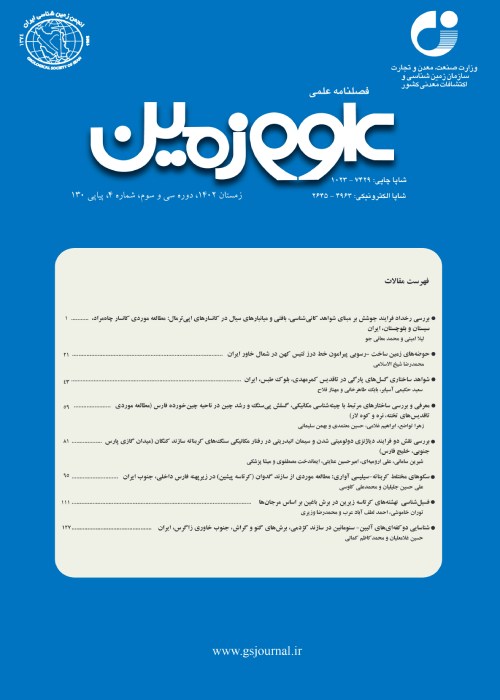Detecting hydrothermal alteration zones by alteration box plot and mass change calculations using immobile elements in the Gezildash massive sulfide copper deposit of Khoy
Author(s):
Abstract:
The Ghezildash massive sulphide copper deposit is located in the northwest of Iran. The area is a part of the ophiolotic colored mélange zone of NW Iran, also known as KhoyMaku colored mélange. Copper mineralization occurred in part of basaltic meta-volcanic rocks, and extensive alteration zones such as chloriticepidoitic along with minor carbonate and sericitic zones are consequently developed in the area. This paper aims at identifying hydrothermal alteration zones related to massive sulphide deposit particularly those associated with chloritic zones where the mineralization have been identified. Another aspect is to determine the elemental enrichment and depletion before and after alterations in the host rock. For this purpose, the alteration box plot was used, which approved Trend 4 of chlorite-carbonate zone in much of the samples and Trend 5 of sericitecarbonate in few samples. Furthermore, thin section studies showed similar results, confirming the method used. Maclean method as a useful reconnaissance tool for mineralized zones was then applied to identify the enriched and depleted alteration zones between unaltered host rock and altered chloritic and sericitic zones. Results of McLean method revealed in the chloritic alteration zone large enrichment of Fe and Mg and depletion of Na, K and Ca elements, which have occurred due to decomposition of feldspars in the rock during chloritic alteration. It was also observed that these rocks in the chloritic alteration zone were subjected to a moderate increase in Cu, Zn, Co, and V contents. Also, sericitic alteration zone showed a moderate enrichment in Fe and Mg. Therefore, alteration zone detection using box plot and mass change calculations by McLean method enabled us to identify mineralization zones in the Gezildash massive sulphide deposit of Khoy. Characteristic features of detected alterations and geochemical indices obtained by this study suggest the Cyprus type massive sulphide mineralization for the area associated with Cu-Zn enrichment and Ca and Na depletion. In some cases, very minor amount of K enrichment in sericitic zones was also observed. Overview of the deposit represents cluster form in a particular trend that emphasizes its structural control by faults. The presence of ophiolitic mafic volcanic rocks, Ocher horizons, exhalative cherts and regional pyrite horizons are considered as exploration signs for this deposit.
Keywords:
Language:
Persian
Published:
Geosciences Scientific Quarterly Journal, Volume:26 Issue: 101, 2017
Pages:
231 to 244
magiran.com/p1629368
دانلود و مطالعه متن این مقاله با یکی از روشهای زیر امکان پذیر است:
اشتراک شخصی
با عضویت و پرداخت آنلاین حق اشتراک یکساله به مبلغ 1,390,000ريال میتوانید 70 عنوان مطلب دانلود کنید!
اشتراک سازمانی
به کتابخانه دانشگاه یا محل کار خود پیشنهاد کنید تا اشتراک سازمانی این پایگاه را برای دسترسی نامحدود همه کاربران به متن مطالب تهیه نمایند!
توجه!
- حق عضویت دریافتی صرف حمایت از نشریات عضو و نگهداری، تکمیل و توسعه مگیران میشود.
- پرداخت حق اشتراک و دانلود مقالات اجازه بازنشر آن در سایر رسانههای چاپی و دیجیتال را به کاربر نمیدهد.
دسترسی سراسری کاربران دانشگاه پیام نور!
اعضای هیئت علمی و دانشجویان دانشگاه پیام نور در سراسر کشور، در صورت ثبت نام با ایمیل دانشگاهی، تا پایان فروردین ماه 1403 به مقالات سایت دسترسی خواهند داشت!
In order to view content subscription is required
Personal subscription
Subscribe magiran.com for 70 € euros via PayPal and download 70 articles during a year.
Organization subscription
Please contact us to subscribe your university or library for unlimited access!


